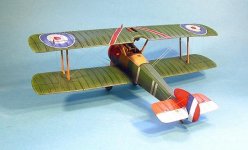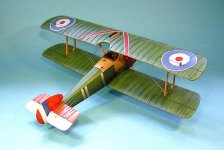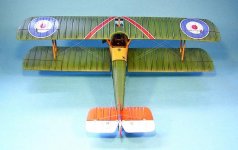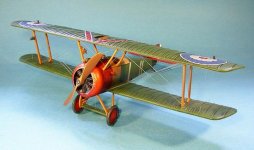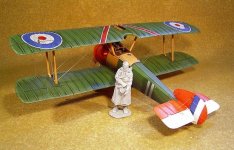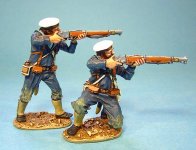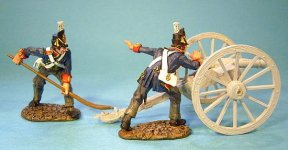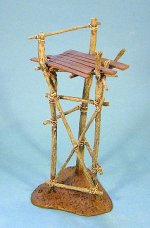Welcome to the latest releases from John and are you ever in for a surprise this time. We knew a new series was coming, but this was not on our suspect list. So we hope you like the surprise as much as we do.
The September releases are now in stock including the Condor Legion and Club Set #4.
Hope to have these on the web site this morning, www.sierratoysoldier.com.
Hope you like them.
Best regards
Mike
Sierra Toy Soldier Company
KNIGHTS OF THE SKIES
The Aces were the top pilots of each nation who had downed at least 5 enemy aircraft during aerial combat.
The governments promoted them to raise morale, civilians adored them for their courage, and skill, and the press were to memorialize them as “Knights Of The Skies”.
Aces presented a vision of war based on past virtues like chivalry and decorum.
They became modern day heroes flying machines, instead of riding horses.
The first aircraft of the collection is the one that became famous because it was the machine that Capt. Roy Brown used to chase Baron von Reichtofen over the Somme on 21st April 1918.
A flight from which the Baron did not return.
Brown had fired at the Baron’s Dr1, and upon landing was told that he had shot it down.
(This machine was then flown by Capt. O W Redgate, who scored two more victories in it that same month.)
There were 3 white bars on the fuselage sides, one ahead of where a roundel might have been, and two aft. A red chevron, edged in white, appeared on the top wing across the centre section.
ACE-10
KNIGHTS OF THE SKIES
SOPWITH CAMEL B7270
No.209 Sqn, Bertangles, April 1918
(1pcs)
NOT LIMITED
Retail us$188
The Sopwith Camel entered squadron service in June 1917 with No.4 squadron of the Royal Air Service, near Dunkirk. The following month, it became operational with No’70 squadron of the Royal Flying Corps. By February 1918, 13 squadrons were fully equipped with the camel
Originally intended as a replacement for the Sopwith Pup, its design was more evolutionary than revolutionary, featuring a box-like fuselage structure, an aluminium engine cowling, plywood-covered panels around the cockpit, and fabric covered fuselage, wings and tail.
Two Vickers machine guns were mounted directly in front of the cockpit, firing forward through the propeller with synchronisation gear.
A metal fairing over the gun breeches created a “hump” that led to the name Camel.
More than 5,000 Camels were produced, and it was responsible for destroying 1,294 enemy aircraft, between June 1917 and November 1918, and was the most successful fighting scout employed by either side in terms of the sheer numbers of victories that it scored.
Figures will be sold separately
Model Weight 138g
SCALE 1/30
MODEL DIMENSIONS approx 11 ½” x 7” x 4”
MATERIALS Mixed Media,
There will be more pieces from this new series available to see at the upcoming Chicago show.
Come see them at the John Jenkins “Meet & Greet” On Saturday between 2 -6 in the Sierra Toy Soldier Room.
RETURN TO MONONGAHELA
THE BATTLE ON THE MONONGAHELA 1755
The effectiveness of many great armies has depended heavily on their NCO’s. These were the Sergeants and Corporals who drilled , trained and importantly steadied the ranks of the men on the day of the battle.
Kipling was to write “ The backbone of the army is the non-commissioned man”
These men did not hold commissions granted by the monarch, and were mainly promoted from the ranks , usually by the regiments Colonel.
BM-25
THE BATTLE ON THE MONONGAHELA 1755,
44th Regiment of Foot ,
British Line Infantry, Sergeant and Corporal
(3pcs)
Limited Edition 300
Retail us$60
THE JACOBITE REBELLION 1745
This new set shows a British Line Infantryman of the 4th Regiment of foot, about to try to “finish off” a fallen Highlander, after what would have been a desperate fight in close quarters.
It also illustrates one of the controversial incidents that took place after the Battle of Culloden had come to an end.
The British General The Duke of Cumberland had been given specific instructions by George II that the Scots had to be punished for supporting Charles. Thus began a dark chapter in British history. Following the battle, British troops began to indiscriminately kill the wounded Jacobites, as well as fleeing clansmen and innocent bystanders, which was to earn Cumberland the nickname “The Butcher”.
JR-18
THE JACOBITE REBELLION 1745
COMBAT SET #4
Wounded Highlander and Line Infantry
2 Figures (2pcs)
Limited Edition 500
Retail us$70
THE FIRST SUDAN WAR 1884-1885
BRITISH NAVAL BRIGADE
It cannot be said that the seamen of the naval brigades were well trained in land/ infantry warfare. Those that had passed through HMS Excellent, the Naval Gunnery School at Whale Island, had received instruction in naval gunnery and gun drill, as well as bome elementary drill on the parade ground for forming fours and squares. Some rifle drill was taught, but the standards of marksmanship was not high, and for those that had not passed through Whale Island, were even less accomplished.
When landed for service in a naval brigade, the individual seaman was armed with a rifle and a cutlass-bayonet. When fixed as a bayonet, the cutlass-bayonet made the rifle very muzzle-heavy and even less accurate than it already was in the hands of the sailors.
SRN-02 - 2 Sailors Firing#1
(2pcs)
NOT Limited Edition
Retail us$60
THE WAR OF 1812
Aiming or "laying" a smoothbore artillery piece was partly art and partly science. The piece was traversed (or aligned in the horizontal plane) by means of handspikes fitted into the trail until the line of sight from the top of the breech through the sighting notch at the top of the muzzle was on target. The piece was then elevated (aligned in the vertical plane) by means of the elevating screw. In the heat of battle, the elevation chosen was usually a matter of judgement on the part of the gun commander although, if there was time and a need for accuracy, he might consult a range table. Because the line of sight was not exactly parallel to the axis of the bore, the gun commander would then calculate the tangential elevation required to com¬pensate for the drop of the projectile in flight.. Experienced gun layers automatically took into account and made al¬lowance for such factors as air temperature, wind direction and velocity, humidity, situation of the target and the elevation of the gun position.
The gun itself was also a factor to be considered as older weapons with worn bores would have more windage and less velocity and would thus require extra elevation. Finally, the personal experience and skill of the gun layer was essential in judging the "fall of the shot" and making the corrections necessary to lay the round on target. In the smoothbore period, good gunlaying was a combination of technology and technique that required an experienced eye.
BCHART-02
THE WAR OF 1812
The Battle of Chippawa, 5th July 1814
British Foot Artillery, 2 Crew Aiming,
(2pcs)
Not Limited Edition
Retail us$60
THIS SET DOES NOT INCLUDE THE GUN
THE RAID ON ST. FRANCIS
WISTOCK-04
INDIAN VILLAGE STOCKADE
WATCHTOWER
(1pc)
Not Limited Edition
Retail us$42
Model Dimensions 6 ¾”x 3 ¼” x 3 ¼”
JJ DESIGNS COLLECTORS’ CLUB 2009-2010
There will be no further Special Collector Club sets this year
JJ DESIGNS COLLECTORS’ CLUB SET#5
STATUS –LIMITED EDITION 366
IN PRODUCTION
ESTIMATED DELIVERY DECEMBER 2010
SHOWS
John Will be attending this years’ Toy Soldier show in Chicago. On Saturday he will in the Sierra Toy Soldier Room, showing off his latest releases, some prototypes, signing sets and having a chat. So come join us for a “Meet & Greet", Saturday between 2 - 6.
Open House
John will be attending an OPEN HOUSE at the Toy Soldier Shoppe
Wisconsin
Saturday, September 18th, 10am - 4pm
Light refreshments will be served.
Please contact for further details
Paul Herrmann
The Toy Soldier Shoppe,
3775 S. 108th St.
Greenfield,
WI 53228, USA
Tel (414) 302 1850
e-mail pherrmann@toysoldiershoppe.net
As always hope you like the new releases.
Best regards
Mike
Sierra Toy Soldier Company
The September releases are now in stock including the Condor Legion and Club Set #4.
Hope to have these on the web site this morning, www.sierratoysoldier.com.
Hope you like them.
Best regards
Mike
Sierra Toy Soldier Company
KNIGHTS OF THE SKIES
The Aces were the top pilots of each nation who had downed at least 5 enemy aircraft during aerial combat.
The governments promoted them to raise morale, civilians adored them for their courage, and skill, and the press were to memorialize them as “Knights Of The Skies”.
Aces presented a vision of war based on past virtues like chivalry and decorum.
They became modern day heroes flying machines, instead of riding horses.
The first aircraft of the collection is the one that became famous because it was the machine that Capt. Roy Brown used to chase Baron von Reichtofen over the Somme on 21st April 1918.
A flight from which the Baron did not return.
Brown had fired at the Baron’s Dr1, and upon landing was told that he had shot it down.
(This machine was then flown by Capt. O W Redgate, who scored two more victories in it that same month.)
There were 3 white bars on the fuselage sides, one ahead of where a roundel might have been, and two aft. A red chevron, edged in white, appeared on the top wing across the centre section.
ACE-10
KNIGHTS OF THE SKIES
SOPWITH CAMEL B7270
No.209 Sqn, Bertangles, April 1918
(1pcs)
NOT LIMITED
Retail us$188
The Sopwith Camel entered squadron service in June 1917 with No.4 squadron of the Royal Air Service, near Dunkirk. The following month, it became operational with No’70 squadron of the Royal Flying Corps. By February 1918, 13 squadrons were fully equipped with the camel
Originally intended as a replacement for the Sopwith Pup, its design was more evolutionary than revolutionary, featuring a box-like fuselage structure, an aluminium engine cowling, plywood-covered panels around the cockpit, and fabric covered fuselage, wings and tail.
Two Vickers machine guns were mounted directly in front of the cockpit, firing forward through the propeller with synchronisation gear.
A metal fairing over the gun breeches created a “hump” that led to the name Camel.
More than 5,000 Camels were produced, and it was responsible for destroying 1,294 enemy aircraft, between June 1917 and November 1918, and was the most successful fighting scout employed by either side in terms of the sheer numbers of victories that it scored.
Figures will be sold separately
Model Weight 138g
SCALE 1/30
MODEL DIMENSIONS approx 11 ½” x 7” x 4”
MATERIALS Mixed Media,
There will be more pieces from this new series available to see at the upcoming Chicago show.
Come see them at the John Jenkins “Meet & Greet” On Saturday between 2 -6 in the Sierra Toy Soldier Room.
RETURN TO MONONGAHELA
THE BATTLE ON THE MONONGAHELA 1755
The effectiveness of many great armies has depended heavily on their NCO’s. These were the Sergeants and Corporals who drilled , trained and importantly steadied the ranks of the men on the day of the battle.
Kipling was to write “ The backbone of the army is the non-commissioned man”
These men did not hold commissions granted by the monarch, and were mainly promoted from the ranks , usually by the regiments Colonel.
BM-25
THE BATTLE ON THE MONONGAHELA 1755,
44th Regiment of Foot ,
British Line Infantry, Sergeant and Corporal
(3pcs)
Limited Edition 300
Retail us$60
THE JACOBITE REBELLION 1745
This new set shows a British Line Infantryman of the 4th Regiment of foot, about to try to “finish off” a fallen Highlander, after what would have been a desperate fight in close quarters.
It also illustrates one of the controversial incidents that took place after the Battle of Culloden had come to an end.
The British General The Duke of Cumberland had been given specific instructions by George II that the Scots had to be punished for supporting Charles. Thus began a dark chapter in British history. Following the battle, British troops began to indiscriminately kill the wounded Jacobites, as well as fleeing clansmen and innocent bystanders, which was to earn Cumberland the nickname “The Butcher”.
JR-18
THE JACOBITE REBELLION 1745
COMBAT SET #4
Wounded Highlander and Line Infantry
2 Figures (2pcs)
Limited Edition 500
Retail us$70
THE FIRST SUDAN WAR 1884-1885
BRITISH NAVAL BRIGADE
It cannot be said that the seamen of the naval brigades were well trained in land/ infantry warfare. Those that had passed through HMS Excellent, the Naval Gunnery School at Whale Island, had received instruction in naval gunnery and gun drill, as well as bome elementary drill on the parade ground for forming fours and squares. Some rifle drill was taught, but the standards of marksmanship was not high, and for those that had not passed through Whale Island, were even less accomplished.
When landed for service in a naval brigade, the individual seaman was armed with a rifle and a cutlass-bayonet. When fixed as a bayonet, the cutlass-bayonet made the rifle very muzzle-heavy and even less accurate than it already was in the hands of the sailors.
SRN-02 - 2 Sailors Firing#1
(2pcs)
NOT Limited Edition
Retail us$60
THE WAR OF 1812
Aiming or "laying" a smoothbore artillery piece was partly art and partly science. The piece was traversed (or aligned in the horizontal plane) by means of handspikes fitted into the trail until the line of sight from the top of the breech through the sighting notch at the top of the muzzle was on target. The piece was then elevated (aligned in the vertical plane) by means of the elevating screw. In the heat of battle, the elevation chosen was usually a matter of judgement on the part of the gun commander although, if there was time and a need for accuracy, he might consult a range table. Because the line of sight was not exactly parallel to the axis of the bore, the gun commander would then calculate the tangential elevation required to com¬pensate for the drop of the projectile in flight.. Experienced gun layers automatically took into account and made al¬lowance for such factors as air temperature, wind direction and velocity, humidity, situation of the target and the elevation of the gun position.
The gun itself was also a factor to be considered as older weapons with worn bores would have more windage and less velocity and would thus require extra elevation. Finally, the personal experience and skill of the gun layer was essential in judging the "fall of the shot" and making the corrections necessary to lay the round on target. In the smoothbore period, good gunlaying was a combination of technology and technique that required an experienced eye.
BCHART-02
THE WAR OF 1812
The Battle of Chippawa, 5th July 1814
British Foot Artillery, 2 Crew Aiming,
(2pcs)
Not Limited Edition
Retail us$60
THIS SET DOES NOT INCLUDE THE GUN
THE RAID ON ST. FRANCIS
WISTOCK-04
INDIAN VILLAGE STOCKADE
WATCHTOWER
(1pc)
Not Limited Edition
Retail us$42
Model Dimensions 6 ¾”x 3 ¼” x 3 ¼”
JJ DESIGNS COLLECTORS’ CLUB 2009-2010
There will be no further Special Collector Club sets this year
JJ DESIGNS COLLECTORS’ CLUB SET#5
STATUS –LIMITED EDITION 366
IN PRODUCTION
ESTIMATED DELIVERY DECEMBER 2010
SHOWS
John Will be attending this years’ Toy Soldier show in Chicago. On Saturday he will in the Sierra Toy Soldier Room, showing off his latest releases, some prototypes, signing sets and having a chat. So come join us for a “Meet & Greet", Saturday between 2 - 6.
Open House
John will be attending an OPEN HOUSE at the Toy Soldier Shoppe
Wisconsin
Saturday, September 18th, 10am - 4pm
Light refreshments will be served.
Please contact for further details
Paul Herrmann
The Toy Soldier Shoppe,
3775 S. 108th St.
Greenfield,
WI 53228, USA
Tel (414) 302 1850
e-mail pherrmann@toysoldiershoppe.net
As always hope you like the new releases.
Best regards
Mike
Sierra Toy Soldier Company


